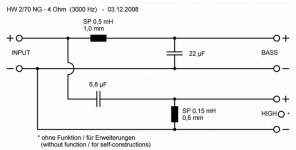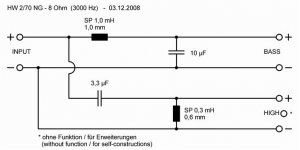Hi,
Has anyone had any experience (or possess the knowledge for an educated opinion) regarding matching different impedance drivers, via a crossover circuit - e.g. 6 Ohm woofer & 8 Ohm tweeter (or vice-versa)
I know impedances alter with frequency so could I get an unlucky mismatch or a lucky match or ……… “is 6 Ohm and 8 Ohm close enough for jazz”?
Thanks in advance, grateful for any help & advice.
Has anyone had any experience (or possess the knowledge for an educated opinion) regarding matching different impedance drivers, via a crossover circuit - e.g. 6 Ohm woofer & 8 Ohm tweeter (or vice-versa)
I know impedances alter with frequency so could I get an unlucky mismatch or a lucky match or ……… “is 6 Ohm and 8 Ohm close enough for jazz”?
Thanks in advance, grateful for any help & advice.
As mentioned, without driver and cabinet details it is hard to rough something up. But matching a 4 ohm (nominal) bass to an 8 ohm (nominal) tweeter is almost standard practise at the budget end. Usually all that is required for level matching is a wirewound resistor attenuator on the tweeter. A wirewound input resistor and a Zobel is also good on a tweeter, but the shunt coil gets smaller.
You will notice that the root of the product (LC) of the filter values stays the same for a given crossover frequency. The ratio of root L/C is proportional to the impedance. DC voicecoil resistance of a nominal 8 ohm driver is usually 6 ohms. For a nominal 4 ohm driver it is usually around 3 ohms.
Crossovers
You can simulate the speaker with similar Visaton drivers here. The complete answer.
Downloads
You will notice that the root of the product (LC) of the filter values stays the same for a given crossover frequency. The ratio of root L/C is proportional to the impedance. DC voicecoil resistance of a nominal 8 ohm driver is usually 6 ohms. For a nominal 4 ohm driver it is usually around 3 ohms.
Crossovers
You can simulate the speaker with similar Visaton drivers here. The complete answer.
Downloads
Attachments
Everyone's comments are uncovering, for me, an even greater degree of potential complexity than I had considered. I had thought, naively, that if TS values were followed forensically, together with a perfectly calculated crossover - accounting for driver response & sensitivity, in a rigid cabinet, then one would have built the "perfect" speaker - yes I know nothing's perfect. So all I would have to do is "amend" the 8 Ohm to 6 Ohm using the parallel resistor as Dug suggested. I also thought that using a Zobel circuit would stabilise the impedances enough (bass at least........can Zobel be used for tweeters or would it be audible at high Hz?) that the drivers fluctuating impedances with frequency wouldn't have much effect on crossover component values. I can design crossovers from impedance, capacitance & inductance tables and "match" speakers with the same impedance and choose a sensible crossover frequency BUT I don't have analysis equip to see the effects, only ears. So........ is Dug's suggestion (my preferred route) as good as it gets without an oscilloscope.
So........ is Dug's suggestion (my preferred route) as good as it gets without an oscilloscope.
no, it is not, sorry
not even half way there
ofcourse you can do it that way
it will play, and you may even enjoy it
just dont think it will be very good
Thanks Tinitus, both project and a genuine learning point (teach a man to fish etc.) The project is marrying a ribbon tweeter (to be used as a super tweeter - this causes lengthy debate and passionate opinions in itself) to another speaker cabinet but where the tweeter is 8 Ohm and the cab is 6 Ohm pre crossover. This is partly an experiment because I've never heard a ST before and I won't hang myself if I don't like the result BUT the knowledge is more important because it makes it makes experimentation less daunting. I'd also like to try the ribbon tweeters with other units which could be of a different impedance if I don't buy brand new, so the facility to accurately and "scientifically" match speakers would help me immensely.
well, basicly you need two different speakers
one you can use for listening(a proven DIY design)
and one for 'learning' and having fun(your own experiment design)
the first one, for listening, build a good 'simple' passive speaker
the other 'experimental' one, I would suggest active
its more like a building brick you can change again and again
one you can use for listening(a proven DIY design)
and one for 'learning' and having fun(your own experiment design)
the first one, for listening, build a good 'simple' passive speaker
the other 'experimental' one, I would suggest active
its more like a building brick you can change again and again
Ok thanks Tinitus, can you give any help on the direction(s) to go in with mismatched driver impedances and matching them via the crossover & associated components – any associated maths you can offer would be great too, relating it to your reply on Dug’s suggestion regarding using a resistor to adjust the tweeters’ impedance. You say it may not be very good, could you explain this? Thanks again.
- Status
- This old topic is closed. If you want to reopen this topic, contact a moderator using the "Report Post" button.
- Home
- Loudspeakers
- Multi-Way
- 6 Ohm Woofer & 8 Ohm Tweeter

